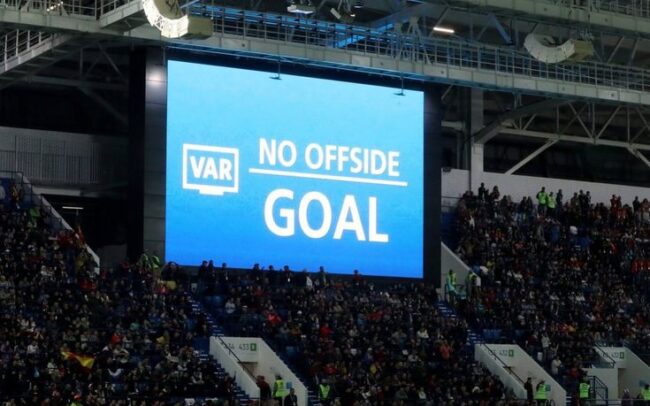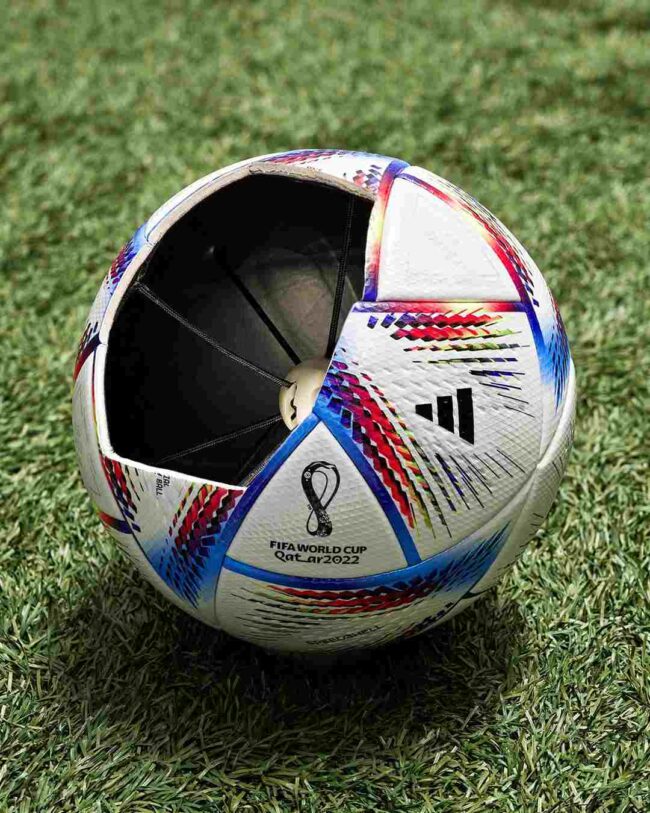FIFA recently announced that semi-automated offside technology will be used at the 2022 FIFA World Cup in Qatar to assist in making tight offside decisions and speed up the use of VAR.
The new technology will serve as a support tool for the video match officials and the on-field referees; to help them make faster, more accurate and more reproducible offside decisions during matches.
The process of making a definitive offside call will be cut from around 70 seconds to just 25 seconds.
The semi-automated offside technology was successfully trialled at the 2021 FIFA Arab Cup and also at the last edition of the FIFA Club World Cup.
In this post, FootballOrbit brings what you need to know about the newly invented football technology.
What led to the invention of the semi-automated offside technology?

The Video Assistant Referee (VAR) was successfully introduced at the 2018 FIFA World Cup in Russia and has been adopted by various leagues and tournaments since.
The VAR was introduced to help referees make more accurate decisions, but it did not completely erase the menace of controversial decisions though, as officials still tend to make errors sometimes.
FIFA President, Gianni Infantino, had declared in The Vision 2020-23 that FIFA would strive to harness the full potential of technology in football and further enhance VAR.
In the following years, football’s governing body has continued to deploy cutting edge technology in the round-leather game.
By working with adidas and other partners — especially with the Working Group for Innovation Excellence and technology providers — FIFA has spent the last few years further improving the VAR system, which has now culminated in the invention of semi-automated offside technology.
What is the semi-automated offside technology?
It is an Artificial Intelligence (AI) device introduced to help VAR make faster and more accurate offside decisions by automatically determining the relative position of the players at the exact moment the ball is played.
Match officials will receive offside alerts from it and then decisions will be manually validated before being communicated to the on-field referee.
Communication with fans inside stadiums will also be improved with a 3D animation displayed on big screens, and to television viewers at home, showing how the offside decision was reached.
“At the FIFA World Cup in 2018, FIFA took the brave step to use VAR technology on the world’s biggest stage, and it has proven to be an undisputable success. Semi-automated offside technology is an evolution of the VAR systems that have been implemented across the world. This technology is the culmination of three years of dedicated research and testing to provide the very best for the teams, players and fans who will be heading to Qatar later this year, and FIFA is proud of this work, as we look forward to the world seeing the benefits of semi-automated offside technology at the FIFA World Cup 2022. FIFA is committed to harnessing technology to improve the game of football at all levels, and the use of semi-automated offside technology at the FIFA World Cup in 2022 is the clearest possible evidence.”
FIFA President Gianni Infantino on the semi-automated offside technology
Pierluigi Collina, chairman of the FIFA Referees Committee
“VAR has already had a very positive impact on football and we can see that the number of major mistakes has already been dramatically reduced. We expect that semi-automated offside technology can take us a step further. We are aware that sometimes the process to check a possible offside takes too long, especially when the offside incident is very tight. This is where semi-automated offside technology comes in – to offer faster and more accurate decisions. The testing has been a major success and we are very confident that, in Qatar, we will have a very valuable support tool to help referees and assistant referees make the best and most correct decision on the field of play. I know that someone called it ‘robot offside’; it’s not. The referees and the assistant referees are still responsible for the decision on the field of play.”
How does the semi-automated offside technology work?

At the moment, VAR can only use broadcast cameras to make offside decisions. But with semi-automated offside technology, cameras will be set up on the roof of the stadiums and they will be able to track all 22 players to calculate their exact position on the pitch.
According to FIFA, the new technology uses 12 dedicated tracking cameras mounted underneath the roof of the stadium to track the ball and up to 29 data points of each individual player, 50 times per second, calculating their exact position on the pitch. The 29 collected data points include all limbs and extremities that are relevant for making offside calls.
A sensor will be placed in the middle of the match ball and it will send data to the video operation room 500 times per second, allowing a very precise detection of the kick point.
By combining the limb- and ball-tracking data and applying artificial intelligence, the new technology provides an automated offside alert to the video match officials inside the video operation room whenever the ball is received by an attacker who was in an offside position at the moment the ball was played by a team-mate.
Before informing the on-field referee, the video match officials validate the proposed decision by manually checking the automatically selected kick point and the automatically created offside line, which is based on the calculated positions of the players’ limbs. This process happens within a few seconds and means that offside decisions can be made faster and more accurately.
After the decision has been confirmed by the video match officials and the referee on the pitch, the exact same positional data points that were used to make the decision are then generated into a 3D animation that perfectly details the position of the players’ limbs at the moment the ball was played.
This 3D animation, which will always show the best possible perspectives for an offside situation, will then be shown on the giant screens in the stadium and will also be made available to FIFA’s broadcast partners to inform all spectators in the clearest possible way.
More tests will be conducted in the coming months to fine-tune the system before a global standard is implemented to ensure that the new technology can be used in the world of football.
FIFA also promised that all details on the semi-automated offside technology set-up and the connected ball technology will be presented to the teams that have qualified for the FIFA World Cup 2022 at the Team Workshop in Doha on the 4th and 5th of July and thereafter shared with the public.
How long will it take to make decisions?
“I heard of four or five seconds to get the offside decision,” Collina said. “We will decrease from an average of 70 seconds to 20 or 25. It might be less when the offside incident is quite easy buy certainly we can’t get an answer in four or five seconds. This is definitely a wrong expectation. It will be faster, it will be more accurate. These are the objectives.”
Is technology replacing referees in football?
According to Collina — who was voted the world’s best referee for 6 consecutive seasons from 1998 to 2003 and also took charge of the 2002 World Cup final between Brazil and Germany — technology is not here to replace referees but to assist them.
“We have heard about robot referees and similar things,”
“I understand that sometimes this is very good for headlines, but this is not the case.
“The match officials are still involved in the decision-making process, because the semi-automated offside gives an answer only when a player who was in an offside position plays the ball. In other words, the assessment of interfering with an opponent remains the match officials’ responsibility.”
What do you think about the semi-automated offside technology?


